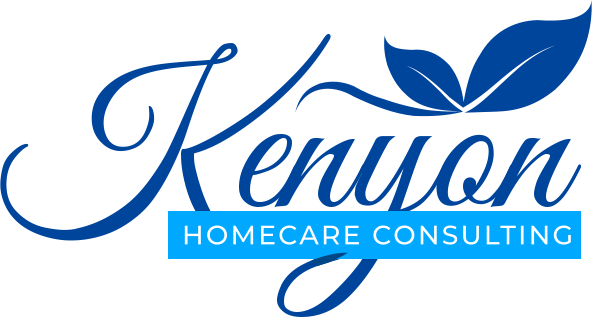Kenyon Connects
OTHERS

By Jed Hammel: I started my career in the 1990s working for GE, a company led by one of the greatest business leaders ever to have lived, Jack Welch. Jack left GE in 2000 (and so did I - haha). One of his great quotes was "What you measure is what you get." In that theme we've been exploring a lot about measurements. When we first started building home care software it was all about transactions: Onboarding a client, scheduling, clocking in and out, billing, etc. This is the work we do to run the business, but what do we do to grow our business - measure! Home Care Growth Measurements - The Most Important Ones! Our customers told us that the most important measures are as follows: Growth: Hours per week and revenue are the key ones. Note that you might think that number of clients should be on that list as well, but remember that an agency with 5 24x7 clients has more revenue than an agency with 80 10-hour per week clients. Gross-Margin: One of the most troubling statistics in the Home Care Pulse Home Care Survey has shown that the profit margins of home care agencies have been dropping in the past two years. It's not surprising because there's increased demand for home care and there have been fewer available caregivers so the amounts we're paying caregivers have gone up. To combat this, agencies need to charge more and look hard at the cases where the caregiver pay or overtime is eating up all the revenue. Operations: Most of our agencies use electronic clock-ins and clock-outs. On the Medicaid side this is called Electronic Visit Verification (EVV) but essentially all of our clients (including agencies who mostly support private pay and long-term care insurance) are doing it to have real time status and to streamline billing and payroll. Billing for All Available Hours: One metric that some but not all agencies track is whether they're delivering and and getting paid for all of their available hours. Again jumping to the Medicaid side, most Medicaid agreements come with a specifically authorized number of hours (or units) per week or month and the way Medicaid works is that you are encouraged to deliver all the hours be penalized if you go over. Most of you private duty folks are probably counting your blessings that you don't have to deal with that, but a nice thing about it is that it establishes a target number of hours for the agency and let's you know that you're getting it done. What Metrics are Recommended by Home Care Growth Champs like HomeCare Evolution by Steve the Hurricane? Coincidentally, we recently we were joined by Melissa Bagley, one of the expert coaches from Home Care Evolution, on our Home Care Heroes Podcast. You can listen to her episode here: https://podcasts.apple.com/us/podcast/adapting-your-home-care-agency-for-the-future-with/id1548408985?i=1000551422539 Two follow-up thoughts: If there's no way you're going to listen to the podcast, Melissa's recommendations are totally in line with the list above :) If you think Podcasts aren't your thing, you might want to reconsider for the reasons that A) Home Care leaders spend a good amount of time in the car visiting prospects, referral partners and clients, and B) Rather than listening to news (which is mostly bad news), podcasts are educational and uplifting. Best Practices: Dashboards should summarize information so you can get an immediate sense of how things are going. Your dashboard should answer the question "Are we delivering and getting paid for all the services we've been asked to deliver." It's a powerful end to end measure of operational efficiency. Best Practice: Summaries are great, but you need drill down to see where the problems are. Referring to the same dashboard, note that it's great to see a summary, but you also need to be able to drill down to see where the issues lie. Best Practice: Graphs are Nice but Managers generally prefer numbers. A good view of caregiver compliance lets management know at a glance how their caregivers are doing with clock-ins and clock-outs. In this case the pie charts are very useful. By contrast, managers generally prefer numbers and pride themselves on knowing their numbers off the top of their head. Overall business owners can usually tell you their number of clients and weekly hours, whereas recruiters can tell you their number of applicants, number of hires, percentage of candidates attending interviews and percentage hired. Here's a pure numbers dashboard with week by week data. Best Practice: Manage by week, but be prepared to provide data by month, quarter, and other ways. There are weekly summaries of growth with week over week comparisons, but monthly results should be accessible with the touch or a button. Similarly, you want to be able to look at pretty much any time period, but we recommend not looking at less than a week's worth of data because most agencies have fewer visits on the weekends. Takeaways: My church pastor once told me that no matter what sermon they were writing, the initial outline was "What?, So What? and Now What?" So, what should you do after reading this article. Here it is: Identify your key metrics - if you're not sure where to start go with weekly clients, weekly hours of care, gross margin, and recruiting Find an easy way to see the data - hopefully via dashboards with drill down as explained above (if you don't have this, we'd be happy to help - here's how to contact Ankota). Assign leaders to own and drive each of your key metrics Review them regularly, ideally week by week If you have any questions about dashboards or how Ankota's home care management software can help your business, please click below to contact us ! Ankota provides software to improve the delivery of care outside the hospital, focusing on efficiency and care coordination. Ankota's primary focus is on Care Transitions for Readmission avoidance and on management of Private Duty non-medical home care. To learn more, please visit www.ankota.com or contact us . Kenyon Homecare Consulting can help you with all of your agency's needs. Whether you need assistance with your start-up, recruitment and retention, clinical or operational issues, regulatory compliance, or financial concerns, we can help. Call us today at 206-721-5091 or contact us online to see how we can help you reach your goals Kenyon Homecare Consulting reposted this article with permission of Jed Hammel who authored it and originally posted it to the Ankota Blog.

By Stephen Tweed As the home care caregiver shortage continues, we recognize that there is no short-term fix. If you want to be successful in home care over a long period of time, you will need to develop a long term strategic initiative to attract and retain the caregivers you need. That means working diligently to create a great place to work. Crafting Your Company Culture: Creating a great place to work for caregivers means crafting a company culture that is in alignment with the needs and wants of your best caregivers. The most recent Best Caregiver Study from Leading Home Care and the Home Care CEO Forum showed that the most reliable workers in home care want: To do meaningful work To feel valued and respected by their clients, their supervisors, and company owners To have a flexible schedule To receive the proper education and training to do their work To feel fairly paid We define company culture as … “The way we do things around here.” Your culture is influenced by four factors; the leadership style of the CEO, the core values that guide your decisions and actions, the behavior you expect, and the behavior you permit. Building a company culture that will enable you to systematically find and keep the caregivers you need is a long-term commitment. Seven Steps To Crafting Your Company Culture: Crafting your culture is not easy, but there is a system that works. After studying dozens of companies that have crafted amazing cultures, and after interviewing CEOs of these companies, we have developed seven specific steps that are necessary to build a strong culture over the long haul: Define your Core Values Define the behaviors you expect for each Core Value Communicate your values and expected behaviors Train your leaders to Live Your Values Engage your Caregivers Promote Your Culture Reinforce Your Culture After leading this process for a number of home care companies, we’ve found that this seven step process takes at least a year to get through, and you are never done. The largest, privately owned home care company in the world has spent over 40 years working on their culture, and they are not done yet. The good news is, you can start today. Where To Start: The place to begin this process is defining your core values. When we lead this process of crafting your culture, we begin by brainstorming a list of values that members of the leadership team believe are important. Then we discuss each value, and define its meaning. We talk about what it means to live this value. Then, we narrow the list of values down to three. Why three values? Because people can’t remember more than four. If you have seven core values, and people can’t remember that last four then why have them? Pick the three that are most important and that your team members resonate with. Begin there. Top Tier Home Care Companies Are Working on Their Company Culture: As you know by know, through the Home Care CEO Forum and our Home Care Mastermind Groups , we work with companies in the very top tier of our industry. One of the common characteristics of our Top 5% Mastermind Group and our Top 7% Mastermind Group is that they are all working on crafting their company culture. They are working through the steps in this process in varying degrees. The fastest growing companies in these groups have built on their company culture to develop systems to recruit and retain caregivers. We’ve learned that you can only grow your home care company when you are able to attract and retain high quality caregivers, and crafting your company culture is part of that process. This article is being re-published with permission of the writer, Steven Tweed: Stephen Tweed, CSP, is an internationally known health care and business strategist, award winning professional speaker, and published author. He is the CEO of Leading Home Care… a Tweed Jeffries company and the Founder of The Home Care CEO Forum® and Caregiver Quality Assurance®. If you need assistance in your recruitment and retention efforts as well as looking at company culture, call Kenyon Homecare Consulting at 206-721-5091 or contact us online to see how we can help.

If you are members of the National Association for Home Care and Hospice or your respective state associations, then you may have already heard of the "Organization Deactivation Project 2022". If not, then your agency may be at risk if you haven't been servicing Medicare patients in the last year. Many states without licensure require agencies to be Medicare certified in order to meet state requirements for providing services to Medicaid and other non-Medicare payers. So, Medicare certification was a necessity and servicing Medicare patients was not necessarily your target for market share. It appears some agencies have already received letters from their Medicare Administrative Contractor (MAC) if they have not submitted Medicare claims in the past 12-13 months. Ultimately, those organizations in business to serve only Medicaid will want to consider marketing for some Medicare patients. Now, an agency that never plans to bill Medicare may not see an issue with deactivation of Medicare billing privileges. It becomes an issue if CMS wants to potentially revoke enrollment in the Medicare system which would negatively impact those states that have no choice but to be Medicare certified. An agency would then potentially need to submit a new 855 and start the enrollment process for Medicare all over again to bill for services. This would be costly for providers who would be going through additional survey and providing care for free during the interim. Ultimately, this may a be hard push from CMS for states without licensure to put it in place. From the federal level, you can see how this would make sense. It makes the states wholly responsible for those Medicare certified agencies billing for only for Medicaid and non-Medicare payers within the state. If CMS is looking into this, then agencies servicing only Medicaid and Medicaid waivers need to look closely at their patients. Are your dually-eligible patient qualifying for the Medicare home health benefit at different times but not being discharged from a Medicaid plan of care? Now, we have no confirmation that this is something CMS is looking at, but it could potentially show the states that Medicaid dollars are going to patients who qualify for Medicare services. At Kenyon Homecare Consulting, we encourage all agencies to belong to their respective state associations as well as NAHC. There is a wealth of education, advocacy, and resources for agencies. If you need individual consulting or education, please call Kenyon Homecare Consulting at 206-721-5091 or contact us online to see if we can help you achieve your clinical, operational, and financial goals.

Strategic Planning: If It Feels Like And Obligation Today, Then Turn It Into An Opportunity Tomorrow
When you think about strategic planning, do you see it as a positive for your agency? Does your strategic plan bring about necessary change and improvements to your organization? If you can’t say yes, then it is time to change it. We are in agencies throughout the United States and see many different ways agencies approach a strategic plan. So, let’s consider the approach and things that will sabotage your plans coming to fruition. 5 Hindrances to Effective Strategic Planning: In our experience, many ways to focus your plan can be successful. The failure of the plan focuses on these five elements: 1. How do you break down your focus?/ How you spend the time you have? Do you normally break down each department to determine changes? Obviously, you need to put out the biggest fires in your organization first, but we find there often isn’t a structure to how agencies conduct the planning process. Have you given your agency enough time to effectively create the plan or is it done very quickly just to get it finished? 2. Who is involved? Is just the administration? Are a couple people deciding the entire plan without input from others key within the organization? Is the entire process done collectively with department heads, admin and operational leadership involved? Our experience is that those agencies with closed planning processes are not as effective as those who include people who are in the field or in the office doing the day-to-day operations. If you have issues with your accounts receivable, why wouldn’t you include those employees in order to understand what isn’t working? In that exact scenario, we have seen that certain payers change stipulations about billing in a contract and those with signing authority didn’t see it. Therefore, suddenly your department goes from having 6 months to collect on a claim down to 90 days. If you bill insurance monthly and anything is wrong with the claim (wrong insured ID number, name wrong in claim, etc.), you don’t find out until your 90 days clock is almost gone. In this scenario, including the right people allows administration to make changes to the current contract or the billing process to be successful in preventing lost claims. 3. Do you complete an objective SWOT analysis? This may seem obvious, but it really is lacking more than what you think. We often forgot our own biases and relationships we have to our organization and the people in it. We have to be able to see our agencies with fresh eyes. If you need to, consider an operational assessment from an outside source to help you move forward with an effective strategic plan today that will help you provide yourself a basis for development of future plans. 4. How often do you address the plan? The worst thing that can happen to a strategic plan is for it to collect dust in a drawer. A good strategic plan is an ongoing process with goals addressed and achieved and changes made when it is deemed necessary. 5. Who are your change agents? Another land mine to effectively carrying out your strategic plan is putting the wrong employee in charge of executing the change. This happens so often in our agencies. The most logical job title is not always the most effective in carrying out the change. Look to your employees that want a new challenge or those that can be real change agents for other staff. Maybe the supervisor isn’t the one to change a clinical practice in your organization. Maybe a staff nurse that is influential and respected within the organization is in charge of that. Incentivize staff and see what change can look like in your agency. These are our top 5 at Kenyon Homecare Consulting . You potentially can see others within your current strategic planning structure. Give your agency the time it takes to create and develop your process. If you need an operational assessment or some help through your strategic plan, give us a call at 206-721-5091 or contact us online today!

Over the years, Kenyon Homecare Consulting has been asked to provide nurse expert witness work in cases involving malpractice, fraud and abuse, and negligence. In the last several years, we have been most often asked to review cases involving wound care negligence and malpractice. So, consider your own wound care practices and decide if you are at risk of litigation or safe from malpractice. What We Normally See In Negligence Cases: The recurring theme in these cases is a patient who had a wound or develops a pressure ulcer that becomes infected and passes from sepsis. These patients are under the care of a home care, home health, or hospice provider. Let’s look at the list of things to consider in your clinical practice, operations, and documentation to assess your risks: Yes, we said hospice provider: Please note that the terminal status of the patient does not change the potential risk for litigation regardless of the patient being more susceptible to skin breakdown and to succumb to complications from it. Families expect the patient to pass from their terminal illnesses, but not to wound infection. This is always a potential blind spot for hospice agencies. If you have not followed your policies and maintained the proper documentation, then you will still lose a lawsuit even if there is nothing you could have done to prevent the development of the wound. Look at your policies: Are they up to date? We see a lot of policies with treatment now considered to be contraindicated. So, if you are sued and have policies that show you do things potentially detrimental to those in your care, you are at risk. A good example is the use of donut rings as a pressure reduction device. These are now known to cause pressure injury as opposed to prevent it. When you look at the topical treatment, is it synonymous with current industry standards for best practices? Does your policy show protocol for initiation of support surfaces when indicated? What about nutritional support and lab work to monitor nutritional status? If you aren't doing it, then don't mandate it in your policy. Procedures: This is the big one. If your policies are good, then you need to follow them. Now, this is true for everything in our industry, but when you have treatment and prevention measures in policy and do not follow what it says, you will likely lose the case. There are many cases settled because of agencies not following policies and procedures. The minute you are sued, everything about the provision of care goes under the microscope. You need to make sure policies are not so intricate that it is unrealistic for your staff to follow them. You also need to make sure clinical staff knows and understands your policy related to caring for these wounds. We have had cases where a nurse calls the physician and documents asking for the use of a certain treatment that is not in your protocol. Education/Assessment/ Documentation: Having a nursing degree does not mean every nurse can walk into every department and provide competent care in all situations. You cannot assume your nursing staff and therapists are skilled at assessment and know how to recognize the etiology of every wound if you have not provided the teaching. We have seen the documentation that lists a wound as a pressure ulcer and then the next week it is listed as venous stasis. If your staff is not skilled at defining what caused the wound based upon the characteristics, location, and patient medical background, you have not shown competency of staff to provide safe care to the patient. Documentation and interventions need to match the diagnosis. If you have a venous stasis ulcer and interventions are related to pressure relief, you are at risk. You may say this is something that does not happen at your agency, but we see it all the time. Who is responsible?: The answer needs to be everyone who sees that patient. This is often a responsibility delegated just to nursing, but this should never be the case. When you have a patient at risk for skin breakdown, every clinician needs to address it. This means every aide visit, every nursing visit, and every visit made by a therapist. When pulled into the courtroom, you will be asked why no one looked or documented on skin between nursing visits even through the patient had 2 aide visits and 2 therapy visits. You have no protection against the nurse documenting no skin breakdown last Monday but walking into a stage 3 pressure ulcer the next week. These are just some of the considerations for your agency when it comes to keeping your agency safe from a negligence claim related to wound care. At Kenyon Homecare Consulting , we focus on high-quality, patient centered care and helping your agency provide it. Call us today at 206-721-5091 or contact us online and let us help you and your agency achieve the outcomes you desire.

Today's Home Care Growth Kit chapter is all about finding manageable ways for your agency to increase sales as effectively and easy as possible. Most of our "Growth Kit" series shares our own best practices and advice from multiple industry experts, but for this topic we're relying heavily on content from Steve the Hurricane , including his famous slogan "Blow Away the Competition."

The COVID-19 vaccine mandates have been a hot topic for most health care providers. On January 27, 2022, CMS’s MLN Connects posted tools regarding vaccine mandates. Let’s look at the guidance and accessing the tools. The following is a direct excerpt from COVID-19: Tools to Determine if Vaccine Requirements Apply :



